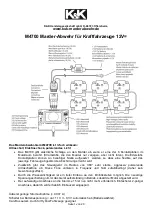
able force will be required to apply the brakes and
braking distance will be subsequently lengthened,
which may cause property damage, personal in-
jury or even death.
6.
Insert the check valve and tee as shown in Figure
14.
Note: two sizes of vacuum line tees are provided
for varying applications.
Insert the check valve between the engine and the
tee. Position the check valve so that the barbed fitting
with the red band (Figure 14) is closest to the engine,
and that the arrow on the check valve (Figure 14) is
pointing toward the engine.
CAUTION
The supplemental braking system will not func-
tion if the check valve is inserted with the arrow
pointing away from the engine.
7.
Press the 1/4" rubber vacuum hose over the bottom
of the tee, as shown in Figure 14.
8.
Remove the tape and, if necessary, cut the 1/4"
vacuum line from the controller to length. Insert the
open end into the 1/4" rubber vacuum hose (Figure
14).
9.
Make certain that all connections are secure.
Figure 14
Figure 13
Note: the vacuum line is used on vehicles with vac-
uum-assisted power brakes. If the vehicle has a full-
time (“active”) power braking system it will not have a
power brake booster (Figure 13). Accordingly, there is
no need to install any of the components in this sec-
tion. Leave the vacuum port as is and proceed to the
next section — “Check the existing lighting.”
1.
Use a section of 1/4" rubber vacuum hose to attach
the 15-foot section of 1/4" nylon vacuum line to the
controller, as shown in Figure 12.
Note: in most applications, a hose clamp or other
crimping device is not required for this connection.
However, check to make certain the vacuum hose is
secure after you have operated InvisiBrake — see "Test
the system."
2.
Seal the open end of the nylon line with tape. Then
route the vacuum line from the controller to the firewall.
Choose a route that will conceal the vacuum line.
3.
Look for a pre-existing hole with a rubber grommet
in the firewall and route the nylon vacuum line through
it.
If there is no pre-existing hole, drill a 1/2" hole
through the firewall.
Before drilling, make certain
you will not damage any components on the other
side.
4.
Route the vacuum line through the engine compart-
ment and to the power brake booster (Figure 13). Avoid
moving parts, sharp edges or hot components such as
the engine or exhaust system. Do not kink the vacuum
line, or bend it to the extent that it crimps or creases.
Do not position the vacuum line close to any heat
source. The heat will soften the nylon, which will
cause the vacuum line to rupture. If the vacuum
line is ruptured, the vehicle's brakes (as well as
the supplemental braking system) will not function
properly.
A loss of vehicular control may result if the
towed vehicle’s brakes do not function properly,
which may cause property damage, personal injury
or even death.
CAUTION
Do not kink the vacuum line, or bend it to the
extent that it crimps or creases — vacuum pressure
will be substantially reduced, or blocked entirely, at
the kink in the line. If vacuum pressure is reduced,
InvisiBrake will not function properly.
5.
Locate the vacuum line coming out of the power
brake booster and cut the line in two places.
Do not drive the vehicle until this installation is
complete — once the vacuum line is cut, the ve-
hicle’s power brakes will not function. Consider-
Attach the vacuum line
11






































